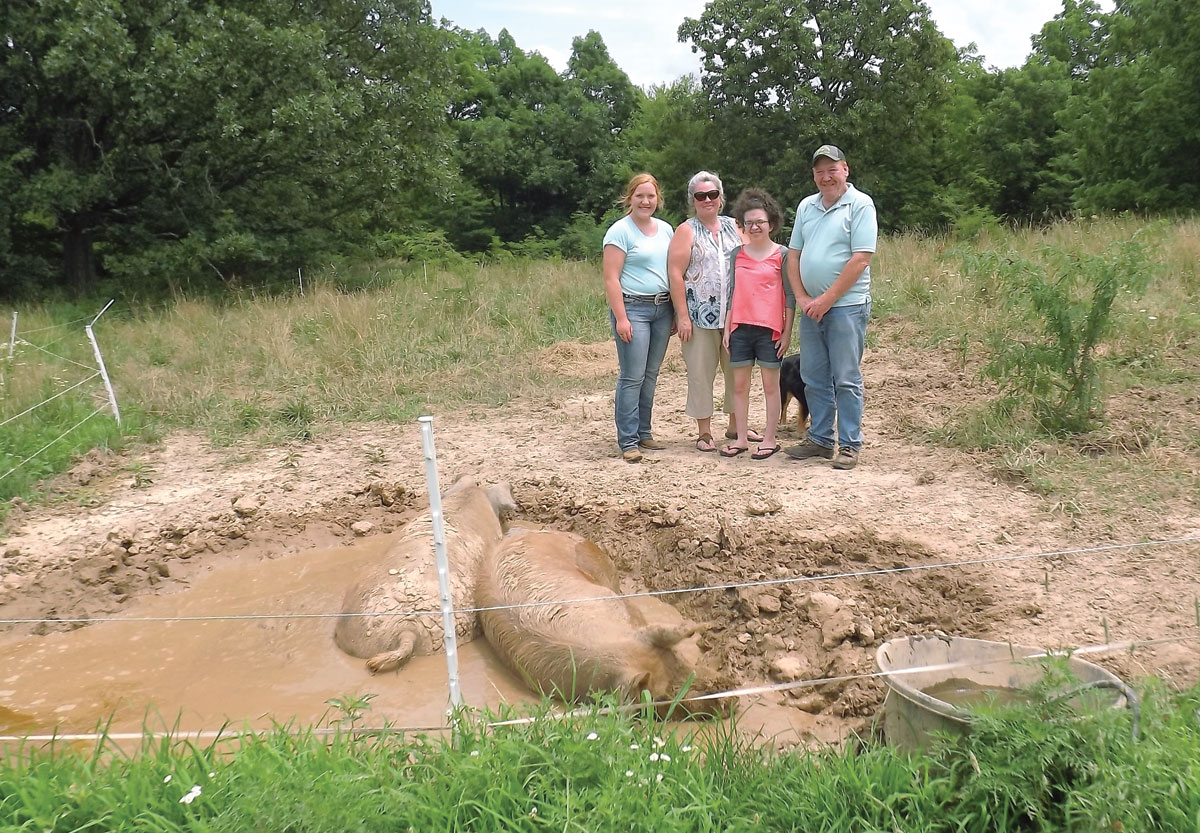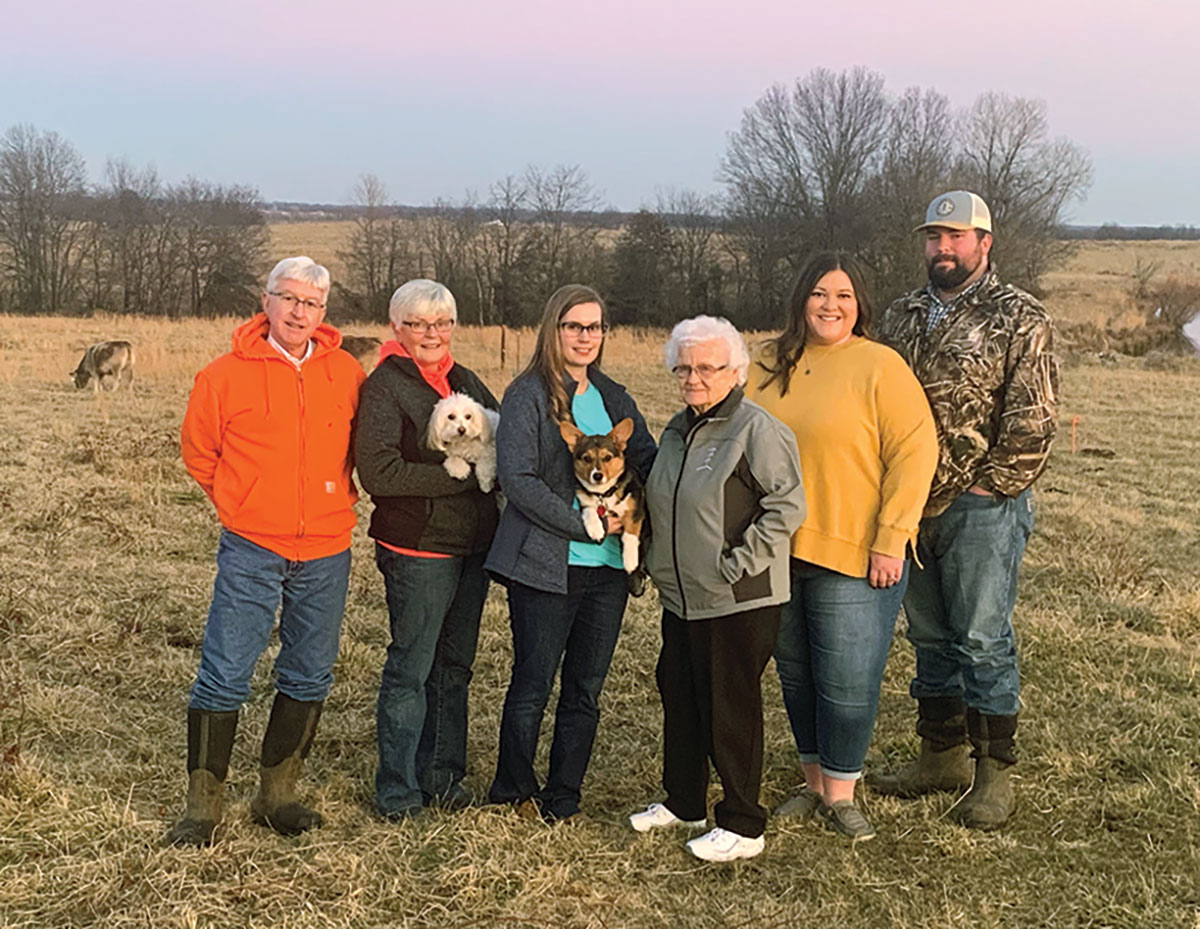
The Whipple family mixes pasture-raised pigs and red cattle
Greg and Kelly Whipple come from farming backgrounds. With daughters Anna and Emily, they farm 250 acres in Windyville, Mo., that has been in Greg’s family for five generations.
Kelly and Emily are the team that actively raises the pasture hogs. They have two Red Wattle sows and use Red Wattle and Berkshire cross boars to produce several litters per year.
“We like the Red Wattle breed because they are easy to handle, have large litters, and do well on pasture,” Kelly explained. “They love rag weed, Queen Anne’s lace, and other plants that cattle won’t eat. We average 12 live piglets per litter and sell most of them as feeder pigs.
“We use heavy-duty electric fence to contain the sows, make sure there is plenty of shade in each paddock, and allow water to drip so that they can make a wallow.”
All pigs are offered a commercial pig grower feed, including the sows.
Kelly said pigs can do well on certain grasses alone, but the time needed to grow a pig on grass is much longer, making it a less than profitable method.
Feeder pigs that are not sold to individuals are marketed through Mid-Missouri Stockyards in nearby Lebanon, Mo.
“We’re slowly building a customer base,” Kelly said.
She added that the pasturing system seems to reduce the need for deworming in the sows, but when piglets come out of their weaning pen, they are dewormed.
They are still developing their animal health protocols, but have had no health issues thus far.
Emily is an active member of the Buffalo High School FFA Chapter. She gets a market hog from Dan Dryer which trains for show at the Dallas County Fair each year.
“I plan to go on to college after I graduate next year and want to get a degree in agriculture” Emily said. “I want to continue farming with my Dad and to work in some type of agriculture business.”
The pigs are a part of Emily’s SAE (Supervised Agriculture Experience) project, so they plan to keep the operation through her high school and college career.
While the Whipple ladies like raising pigs, Greg is more of a cattleman.
Greg has worked with cattle all his life.
“My father (Keith Whipple) raised cattle and was very successful” Greg said. “Kelly and I have used different breeds in our commercial cow herd, including a few South Poll, but we have decided to transition to Red Angus cows and continue using black Angus bulls. Even though Angus are Angus, we have found that the Red Angus is more heat tolerant, is very fertile, has few calving issues, requires less maintenance, and retains the excellent disposition.
“We have a commercial herd of 60 animals, including our black Angus bull. I believe that there is enough difference between Red and black Angus to produce hybrid vigor in the calves and black cattle sell better at auctions.”
The Whipples retain some of their heifers, but since they are planning to transitioning to Red Angus, they are selective about which females they retain.
“We’ve saved back about seven heifers, but since we’re moving to red cattle, we might have to buy some,” Greg said.
Kelly added that she likes the performance of the South Poll cattle as well.
“When it’s hot, our South Polls are out grazing while the other cattle are under a tree,” Kelly said. “They are as fat as they can be.”
Greg and Kelly calve the majority of their herd in the fall and wean most of their caves in late April and May, then calves are sold at about 500 pounds.
“If it looks like we’re going to have lots of grass, we might keep them a little longer,” Kelly said.
While the family works to grow their operation, they’re also working on growing better forages.
“We have gone to intensive grazing management with our herd rather than growing our own hay,” Kelly explained. “Last year, we used the money we had been spending on spring fertilizer to buy hay, which adds many acres for intensive grazing. We have noticed that desirable grasses are starting to come in stronger and thicker and that there are less weeds because the areas are never over grazed.”
The couple said Orcahrdgrass and Timothy are becoming more prevalent in their pastures, reducing the amount of fescue.
“I spend a lot of my time moving electric fence so that the cattle are encouraged to utilize all the forage” Greg said. “I make sure that each grazing area has plenty of shade and access to water. Sometimes I create corridors between shade and fresh grazing so that the cattle will have plenty of grass without damaging the any area.”
They plan to add more warm season grasses in the future.
It is clear that the Whipple family is dedicated to a farming lifestyle. They set goals that improve the land and allow them to successfully raise healthy hogs and cattle on equally healthy land.
“I’d love to retire and just raise cows,” Kelly said.






